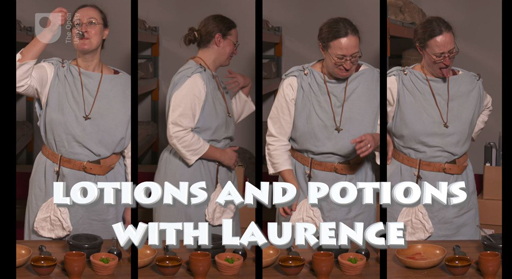2.2 Making collyria
Collyria are very common in the ancient world. They were coloured ointments, often green, used to treat the eyes, and stamped with the mark of their maker.
In Video 4, Laurence Totelin shows how one of these ointments – white collyrium – was made and used.
Download this video clip.Video player: Video 4


Transcript: Video 4 Making collyria
[MUSIC PLAYING]
LAURENCE TOTELIN
I’m going to make a collyrium. And collyrium is an eye remedy. So that’s the Greek and Latin word for eye remedy. And this particular collyrium is called the white collyrium. And you’re going to understand very quickly why it’s called like that.
And it is meant to cure a persistent flow of tears. So what does that mean, a persistent flow of tears? It could mean anything. It could be a symptom for a range of diseases, ranging from the quite severe to things like we would call allergies.
This recipe is measured in drachmae. And drachma is a very common measure in the Greek and Roman world. So a drachma is more or less equivalent to 4.5 grammes. And so today, because it’s easier, I’m going to use a spoonful, which is more or less that amount.
So I’m going to have to take 16 drachmae of the calamine. Then I need 8 drachmae of white lead. The white lead is very dangerous, so I’ve replaced it with more zinc. So you can see that I’m not being very precise. And that’s OK with ancient recipes because they’re all about the proportion not about exact weights.
Then I’m going to take 4 drachmae of starch and four drachmae of gum Arabic and four drachmae of tragacanth gum and then two drachmae of opium. But, of course, I couldn’t use opium, so I’ve just replaced it with white powder. And then I mix.
So now I’m going to pour water. And the recipe states that the water must be rainwater. So we’ve got some rainwater from Wales here. So I pour it. And I start mixing.
So this recipe comes from the writings of Galen. And Galen was a second century AD physician. He was one of the most famous physicians of antiquity. He came from what we would call Turkey, but then he moved to Rome and spent a large portion of his life in Rome where he was one of the physicians to the Emperor Marcus Aurelius and several emperors after him.
So now that I have mixed the preparation, it looks a bit like shaving foam. And that's because the gums in the preparation have acted as an emulsifier. They've made it look like foam. It doesn’t smell very much, but I would say it has a bit of a medication smell.
Now I'm going to take a bit of the preparation, and I’m going to roll it into a sausage shape. And what I would do is to stamp it. So I would stamp it with my name because I am an eye doctor. And I would stamp it with the name of the preparation, the white collyrium. And then I leave it to dry. It takes quite a long time to dry, I would say 24 hours.
So now I have a dry collyrium. And I can sell it to my patients. And what my patients are going to do at home is to take a little bit, crush it in a mortar and pestle. There’s no need for much.
And then they're going to have to apply it. And for that they need a liquid. And the liquid that is very often recommended is the white of an egg. So I have separated the white and the yolk. And then what they would do is take a bit of egg, take a bit of the powder, and then apply it to the corner of their eye.
Video 4 Making collyria
Interactive feature not available in single page view (see it in standard view).
